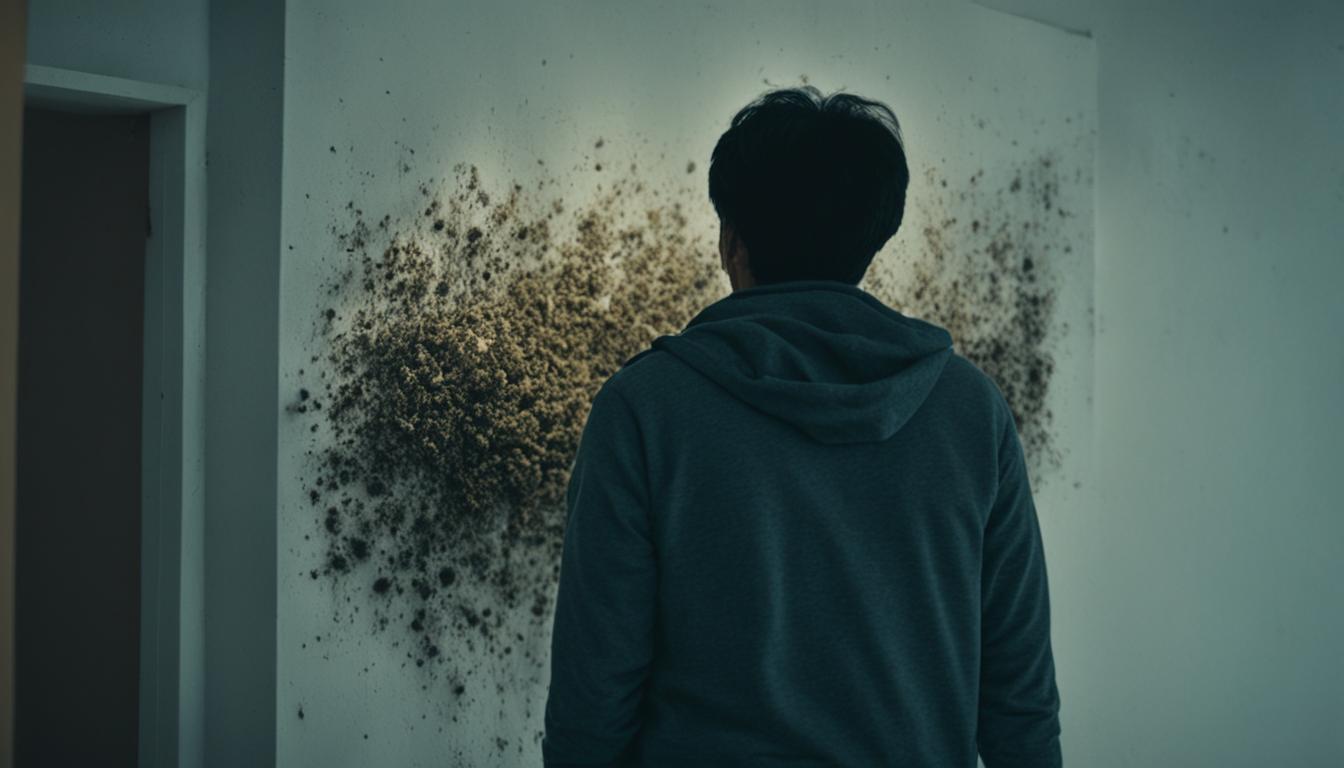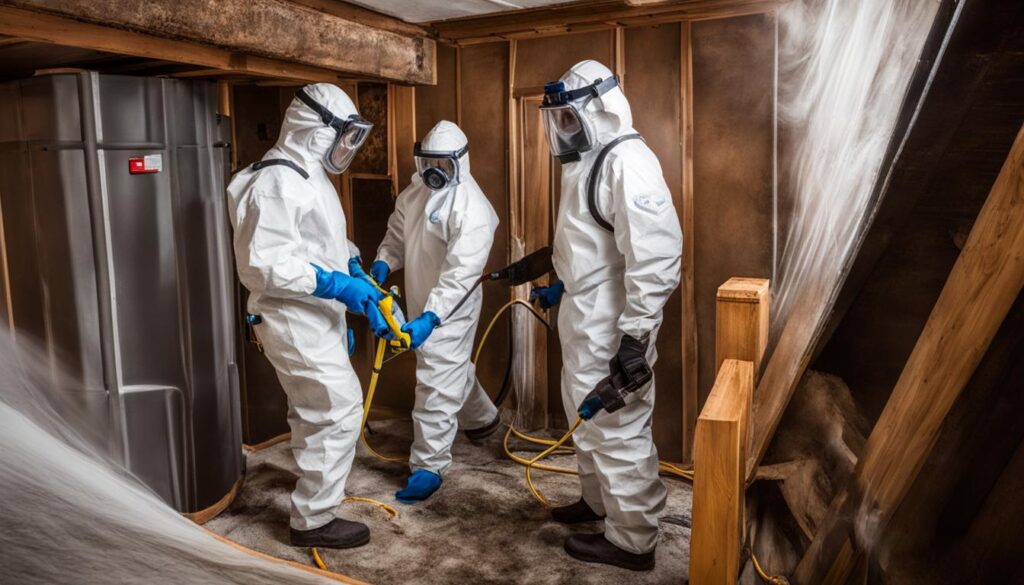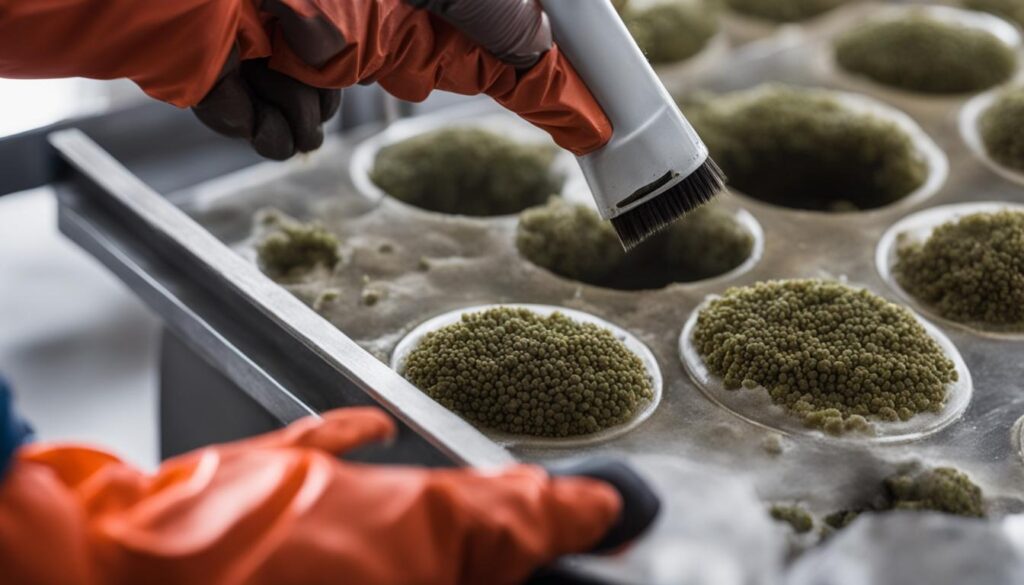
Cladosporium Mold: Risks & Remediation Tips
Cladosporium mold is a type of fungus that can pose serious health risks to individuals when exposed. Symptoms of cladosporium mold exposure may range from respiratory issues to skin irritations, and it is therefore essential to identify and remove any infestations as soon as possible.
In this section, we will explore the potential risks associated with cladosporium mold and provide useful tips for effective mold removal and prevention in your home. By understanding the dangers and taking proactive measures, you can keep yourself and your family safe from harm.
Key Takeaways
- Cladosporium mold can pose serious health risks when exposed.
- Common symptoms of cladosporium mold exposure include respiratory issues and skin irritations.
- Identifying and removing infestations is critical to ensuring a safe living environment.
- Preventative measures like proper ventilation and moisture control can help reduce the risk of mold growth.
- Professional mold removal services can provide expertise in identifying and removing mold infestations.
Understanding Cladosporium Mold
Cladosporium mold is a type of fungus commonly found in both indoor and outdoor environments. This mold comes in different colors ranging from brown to olive-green, black, gray, and even pinkish. It is often found on decaying organic matter such as dead plants, soil, and food. Cladosporium mold can quickly spread through its spores, which are light and easily airborne. These spores are so small that they cannot be seen with the naked eye.
Exposure to cladosporium mold spores can cause a range of health effects. Some people may experience allergy-like symptoms such as sneezing, runny nose, and itchy eyes. Others may experience respiratory issues such as difficulty breathing, chest tightness, and wheezing. In some cases, exposure to cladosporium mold can also cause skin irritations and infections.
It is important to note that the severity of symptoms may vary depending on the individual’s sensitivity to the mold. People with weakened immune systems, asthma, and allergies may experience more severe symptoms than healthy individuals.
To prevent the negative health effects associated with cladosporium mold, it is crucial to identify and address any mold growth in your home. Proper remediation and prevention techniques can help to eliminate mold spores and prevent the growth of cladosporium mold in the future.
“Cladosporium mold can pose a significant risk to human health, particularly to individuals with weakened immune systems, asthma, and allergies.”
Common Symptoms of Cladosporium Mold Exposure
Cladosporium mold is a common type of mold found in both indoor and outdoor environments. The inhalation of Cladosporium mold spores can pose a risk to human health and cause a variety of health issues. Some of the common symptoms associated with Cladosporium mold exposure include:
- Respiratory issues: Individuals may experience respiratory symptoms such as wheezing, coughing, and difficulty breathing.
- Skin irritations: Exposure to Cladosporium mold can cause skin irritations, such as rashes or hives.
- Allergic reactions: Some individuals may develop allergic reactions ranging from nasal congestion, itchy and watery eyes to anaphylaxis.
- Fever and headache: People who are exposed to Cladosporium mold may feel feverish and have headaches, which may affect their daily activities.
If you experience any of these symptoms, it is important to seek medical attention immediately. Furthermore, if you suspect that your home or any other space has been affected by Cladosporium mold, it’s essential to take proper steps to address the issue.
Assessing Cladosporium Mold Infestations
Assessing cladosporium mold infestations in your home is critical for effective remediation. Identifying and confirming the presence of this type of mold can be accomplished through a visual inspection and testing for mold spores in the air and on surfaces. If you suspect the presence of cladosporium mold in your home, don’t hesitate to contact a professional mold remediation company for assistance.
During an inspection, professionals will look for signs of moisture and water damage, which can indicate mold growth. Additionally, they may take air or surface samples to test for the presence of mold spores. These samples will then be analyzed in a lab to determine the type and concentration of mold present.
If mold is identified, it is essential to initiate immediate removal and remediation efforts to prevent further growth and minimize the health risks associated with cladosporium mold exposure. Professional mold remediation services can safely and effectively remove cladosporium mold from your home, utilizing specialized equipment and techniques.
Effective Steps to Identify Cladosporium Mold Infestations:
| Step | Description |
|---|---|
| Check for moisture | Look for damp or wet areas in your home, such as leaky pipes, roofs, or windows, that can lead to mold growth. |
| Visual inspection | Inspect your home for visible mold growth, including black, green, or gray patches on walls, ceilings, and upholstery. |
| Air testing | Air testing can detect the presence of mold spores in the air, even if mold is not visible. |
| Surface testing | Surface testing involves taking samples of visible mold growth to determine the type and concentration of mold present. |
By understanding how to assess cladosporium mold infestations in your home, you can take proactive steps to prevent harmful exposure to your family. Contact FixMold, Florida’s Highest Rated In Mold Assessments, Prevention, and Remediation company, at 305-465-6653 for any assessment, removal, or prevention of cladosporium mold.

Remediation Strategies for Cladosporium Mold
When it comes to cladosporium mold, prompt remediation is vital to minimize exposure and prevent potential health risks. Here are some effective strategies for cladosporium mold removal.
- DIY Remediation: For small areas of mold growth, DIY cleaning techniques can be employed. This includes using a mixture of bleach and water to remove the visible mold growth from hard and non-porous surfaces. Protective gear such as gloves and respiratory masks should be worn during the process, and the affected area should be well-ventilated.
- Hiring Professional Mold Remediation Services: In cases of extensive mold growth or for individuals with health concerns, it is recommended to hire professional mold remediation services. These experts use advanced techniques and equipment to safely remove mold and prevent its recurrence. By hiring professionals, you can ensure the complete remediation of the mold and the safety of your family and home.
Regardless of the methods used for cladosporium mold removal, it is important to assess and address the underlying cause of the mold growth to prevent its recurrence. This may include improving ventilation, repairing leaks, and reducing humidity levels in your home.
To prevent the growth of cladosporium mold, consider investing in a dehumidifier, regularly cleaning and maintaining your HVAC system, and promptly repairing any water damage in your home. By taking these preventive measures, you can ensure a healthy, mold-free environment for you and your family.
The Importance of Prevention
Preventing cladosporium mold growth is key to mitigating potential health risks. The best way to prevent cladosporium mold is to minimize moisture in your home and improve ventilation. Here are some tips to help you prevent cladosporium mold:
- Repair any leaks in your home’s roof, walls, or pipes to prevent excess moisture.
- Ensure that your home has proper ventilation by using exhaust fans in bathrooms and kitchens, and by opening windows periodically to allow fresh air to circulate.
- Use a dehumidifier in areas that are prone to moisture buildup, such as basements and attics.
- Clean and dry any surfaces that become wet or damp as soon as possible, including walls, floors, and carpets.
- Regularly inspect and clean your home’s HVAC system to ensure that it is functioning properly and not contributing to excess moisture buildup.
By following these simple tips, you can significantly reduce the risk of cladosporium mold growth in your home.
Understanding Cladosporium Mold Allergies
Individuals with a cladosporium mold allergy can experience a range of symptoms, including itching, redness, and watery eyes, sneezing, congestion, and coughing. In more severe cases, individuals can experience asthma-like symptoms such as shortness of breath, wheezing, and chest tightness. These symptoms occur due to an allergic reaction to the mold spores that cladosporium mold produces.
If you suspect you have a cladosporium mold allergy, it’s vital to consult an allergist for a proper diagnosis. They will perform various tests to determine if you are allergic to cladosporium mold and if it’s the cause of your symptoms.
There are several treatment options available for individuals with a cladosporium mold allergy. Antihistamines, decongestants, and nasal steroids can help relieve mild allergy symptoms. Immunotherapy, or allergy shots, is also a treatment option for those with severe symptoms. Avoiding exposure to cladosporium mold is crucial in preventing allergic reactions, and hiring professional mold assessment and remediation services, such as those provided by FixMold, can eliminate the source of exposure in your environment.
“If you suspect you have a mold allergy, seek medical attention, and avoid exposure to the mold in question to prevent health risks.”
Health Risks of Cladosporium Mold
Exposure to cladosporium mold can lead to various health problems, which can range from mild to severe. The severity of the symptoms can depend on the extent of exposure and the person’s sensitivity to the mold.
Some individuals may experience respiratory issues like wheezing, coughing, and difficulty breathing. In severe cases, cladosporium mold exposure can cause bronchitis, asthma, or other chronic lung diseases.
Studies have also shown that exposure to cladosporium mold can lead to sinus infections, which can cause lasting pain and pressure in the sinuses.
In addition to respiratory and sinus issues, exposure to cladosporium mold can also cause skin irritation, eye irritation, and headaches. Individuals with weakened immune systems may be more susceptible to developing persistent infection caused by this type of mold.
It is important to address any mold in your home, including cladosporium, to avoid adverse health effects. Contact FixMold at 305-465-6653 for professional mold assessment and remediation services.
When facing health risks caused by cladosporium mold, it is crucial to seek medical attention promptly. Treatment options vary based on the severity and duration of exposure. In some cases, symptoms may subside when exposure to the mold is reduced or eliminated.
If you suspect cladosporium mold exposure, it is also important to take preventive measures to avoid future exposure. Proper ventilation and moisture control in your home can help prevent mold growth and reduce the risk of health problems.
Cladosporium Mold Treatment Options
If you suspect exposure to cladosporium mold and experience any related symptoms, prompt treatment is necessary. The type of treatment will depend on the severity of exposure and the extent of your symptoms.
In most cases, treatment involves addressing any underlying respiratory issues that have arisen due to mold exposure. Treatment may include over-the-counter medications or prescriptions to manage coughing, wheezing, or other respiratory symptoms.
Note: Any persistent symptoms should be assessed by a medical professional to ensure proper diagnosis and treatment.
“Prompt treatment is critical in minimizing potential health risks associated with exposure to cladosporium mold.”
If mold exposure has resulted in an allergic reaction, over-the-counter antihistamines or prescription medications may be recommended. These medications can alleviate many of the symptoms associated with mold allergies, including sneezing, itching, and watery eyes.
Note: Always consult your doctor before taking any new medication, even those available over the counter.
If your home has an infestation of cladosporium mold, the first step is to remove the source of moisture which caused the mold to grow. Proper ventilation and dehumidification techniques can also help prevent future mold growth.
If you suspect mold growth in your home, do not attempt to remove it yourself – call a professional mold remediation company like FixMold at 305-465-6653 for safe and effective mold removal.
Professional Mold Assessment and Remediation Services
While there are DIY methods for cladosporium mold removal, hiring professionals can ensure the complete eradication of the mold in your home. FixMold, Florida’s Highest Rated In Mold Assessments, Prevention, and Remediation company, has the expertise and equipment to assess and remove cladosporium mold effectively and safely.
FixMold’s mold remediation services start with a thorough assessment to identify the source of the mold growth and extent of the infestation. Then, their team of experts employs state-of-the-art equipment and techniques to remove the mold and ensure that the affected area is properly sanitized.
By hiring FixMold, you can be confident that your home is in good hands and that your family’s health is not at risk from cladosporium mold exposure. Contact FixMold at 305-465-6653 to schedule a mold assessment and remediation appointment.

Prevention is also essential in reducing the risk of cladosporium mold growth in your home. FixMold’s prevention services will help you identify and address potential moisture issues before they lead to mold growth. By focusing on prevention, you can ensure that your home remains safe and healthy for years to come.
Effective Measures for Cladosporium Mold Prevention
Prevention is key to avoiding cladosporium mold infestations. Follow these useful measures and best practices to eliminate moisture and prevent mold growth:
- Regular cleaning: Keep your home clean and dust-free to avoid mold buildup. Clean up spills and leaks as soon as they occur.
- Proper ventilation: Ensure proper air circulation and ventilation in your home by using exhaust fans and opening windows regularly. This helps prevent moisture buildup, reducing the risk of mold growth.
- Moisture control: Address any water damage or leaks immediately to prevent mold growth. Consider using a dehumidifier to control indoor humidity levels.
- Regular inspection: Inspect your home regularly for signs of mold growth, such as musty odors and visible mold growth on walls and ceilings.
Implementing these effective measures can help you maintain a healthy and mold-free home. Remember, early detection and prevention are key to avoiding cladosporium mold infestations.
Conclusion
Cladosporium mold can pose a significant risk to your health and well-being. It is essential to understand the symptoms of exposure, assess any possible infestations, and take preventative measures to avoid further growth. By adopting best practices for moisture control and ventilation, you can minimize the risk of mold growth in your home.
If you suspect a cladosporium mold infestation, it is crucial to seek professional assessment and remediation services promptly. FixMold, Florida’s highest-rated mold assessment, and remediation company can help you with all your mold-related needs. Call them at 305-465-6653 for assistance.
Remember, your health and the safety of your home should always be a top priority. With the proper precautions and support from experienced professionals, you can take control of any potential mold problems and create a healthier living environment for you and your loved ones.
FAQ
What are the symptoms of cladosporium mold exposure?
The symptoms of cladosporium mold exposure can vary, but commonly include respiratory issues such as coughing, sneezing, wheezing, and shortness of breath. Other symptoms may include itchy, watery eyes, skin rashes, and nasal congestion.
How can I remove cladosporium mold from my home?
Cladosporium mold can be removed from your home by thoroughly cleaning affected areas with a solution of bleach and water. It is important to wear protective gear such as gloves and a mask while cleaning. For extensive mold growth or if you are unsure about proper removal techniques, it is recommended to hire a professional mold remediation service.
How can I prevent cladosporium mold growth in my home?
To prevent cladosporium mold growth in your home, it is important to control moisture levels. Ensure proper ventilation in areas prone to dampness, such as bathrooms and basements. Fix any leaks or water damage promptly, and use dehumidifiers in areas with high humidity. Regularly clean and dry areas susceptible to mold growth, such as shower curtains, air conditioning units, and window sills.
Are cladosporium mold spores harmful?
Cladosporium mold spores can be harmful if inhaled or come into contact with sensitive individuals. They can cause allergic reactions and respiratory symptoms, especially in individuals with pre-existing respiratory conditions or weakened immune systems.
What are the health effects of cladosporium mold?
The health effects of cladosporium mold exposure can range from mild allergic reactions to more severe respiratory symptoms. Prolonged exposure to cladosporium mold may lead to chronic sinus infections, asthma exacerbation, or even fungal infections in individuals with compromised immune systems.
How can I treat cladosporium mold-related health problems?
Treatment for cladosporium mold-related health problems typically involves addressing the underlying symptoms. This may include the use of antihistamines or inhalers for respiratory symptoms, topical creams for skin irritations, and medications to manage sinus infections. If symptoms persist or worsen, it is important to consult a healthcare professional for appropriate treatment.




